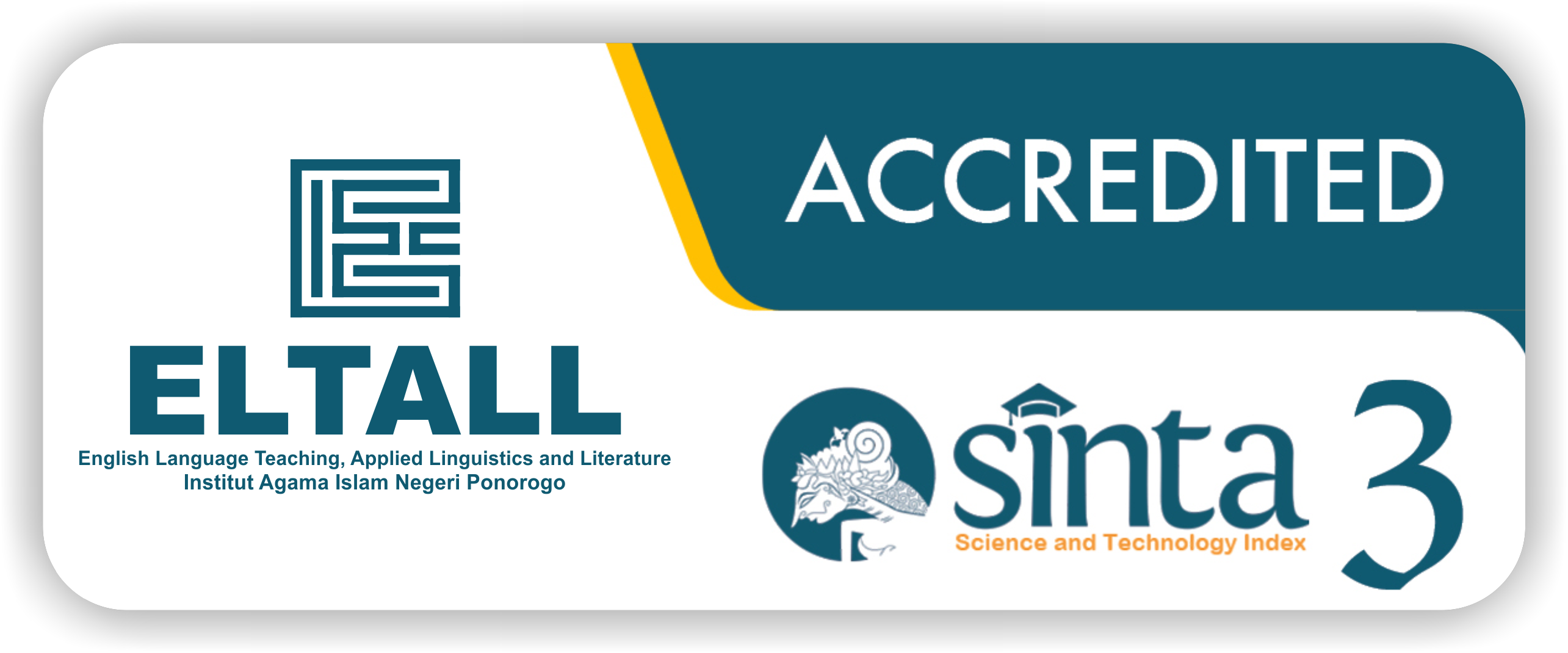DIGITAL LITERACY IN EFL TEACHING
DOI:
https://doi.org/10.21154/eltall.v2i2.3213Keywords:
Digital Literacy, EFL Learning, Language SkillsAbstract
Many questions have aroused in terms of media and technology used and its implication for language teaching and learning. The focus is on how students can be critically aware of media, especially digital media, for their learning. Thus, the use of media in education impacts educational creativity development, such as digital technology applications. In terms of learning, digital literacy is the competency in understanding and using digital technologies effectively for learning. Research has already explored the need for digital literacy in the classroom. This recent paper tries to figure out how digital literacy is implemented in the teaching of ESP students. Furthermore, the method used to describe the idea of this paper is a conceptual paper in which the writer tries to figure out how digital learning is implemented for learning. The writer used literature review from some journal articles and books written by the experts to gather the data. In conclusion, applying digital literacy must be well prepared on the way how it is used. It must relate to their competence, learning objectives, and language skills being taught. Indeed, once the students are familiar with the technology being used, they significantly improve their skills.
References
Benson, P. & Chik, A. (2010). New literacies and autonomy in foreign language learning. In M-J. Luzón, M.N. Ruiz-Madrid & M.L. Villanueva (Eds.) Digital genres, new literacies and autonomy in language learning (pp. 63-80). Newcastle-upon-Tyne: Cambridge Scholars Publishing.
Ciampa, K. (2012). Reading in the Digital Age: Using Electronic Books as a Teaching Tool for Beginning Readers. Canadian Journal of Learning and Technology, 38(2).
Creswell, J. W. (2007). Qualitative inquiry and research design: Choosing among five approaches (2nd ed.). Sage Publications, Inc.
Ertem, I. (2010). The Effect of Electronic Storybooks on Struggling Fourth-Graders' Reading Comprehension. Turkish Online Journal of Educational Technology - TOJET, 9(4), 140-155.
Eisenberg, M. B. (2008). Information literacy: Essential skills for the information age. Journal of Library and Information Technology, 28(2), 39-47.
Grimshaw, S., Dungworth, N., & McKnight, C. (2007). Electronic Books: Children's Reading and Comprehension. British Journal of Educational Technology, 38(4), 583-599.
Hague, C. & Payton, S. (2010). Digital Literacy in Practice (Case Studies of Primary and Secondary Classroom). UK: Futurelab Retrieved from www.futurelab.org.uk
Harris, K. (2015). Integrating digital literacy into English language instruction (Issue Brief). Washington, DC: U.S. Department of Education, Office of Career, Technical and Adult Education. Retrieved from https://lincs.ed.gov/programs/eslpro
Kress, G. R. (2003). Literacy in the new media age. London: Routledge Falmer.
Luzón, M. J. (2002). The spoken features of academic and professional electronic discourse. Oral Skills, Resources, and Proposals for the Classroom: 147-160.
Schmar-Dobler, E. (2003). Reading on the Internet: The link between literacy and technology. Journal of Adolescent & Adult Literacy, 47(1): 80-85.
Thorne, S.L., Black, R., & Sykes, J. (2009). Second language use, socialization, and learning in Internet interest communities and online gaming. Modern Language Journal, 93: 802-821.
Thorne, S. L. (2009). Mediating technologies and second language learning. In J. Coiro, M. Knobel, C. Lankshear, & D. J. Leu (Eds.), Handbook of research on new literacies (pp. 415”“447). New York, NY: Routledge.
Downloads
Published
Issue
Section
License
All articles published in ELTALL (English Language Teaching, Applied Linguistics, and Literature Journal) are licensed under the Creative Commons Attribution-NonCommercial 4.0 International License (CC BY-NC 4.0).
Under this license, authors and readers are free to:
- Share. copy and redistribute the material in any medium or format
- Adapt. remix, transform, and build upon the material
Under the following terms:
- Attribution. You must give appropriate credit, provide a link to the license, and indicate if changes were made. You may do so in any reasonable manner but not in any way that suggests the licensor endorses you or your use.
- Non-Commercial. You may not use the material for commercial purposes.
Notices:
- The licensor cannot revoke these freedoms as long as you follow the license terms.
- No additional restrictions. You may not apply legal terms or technological measures that legally restrict others from doing anything the license permits.
For the full legal code of the license, please visit: https://creativecommons.org/licenses/by-nc/4.0/













